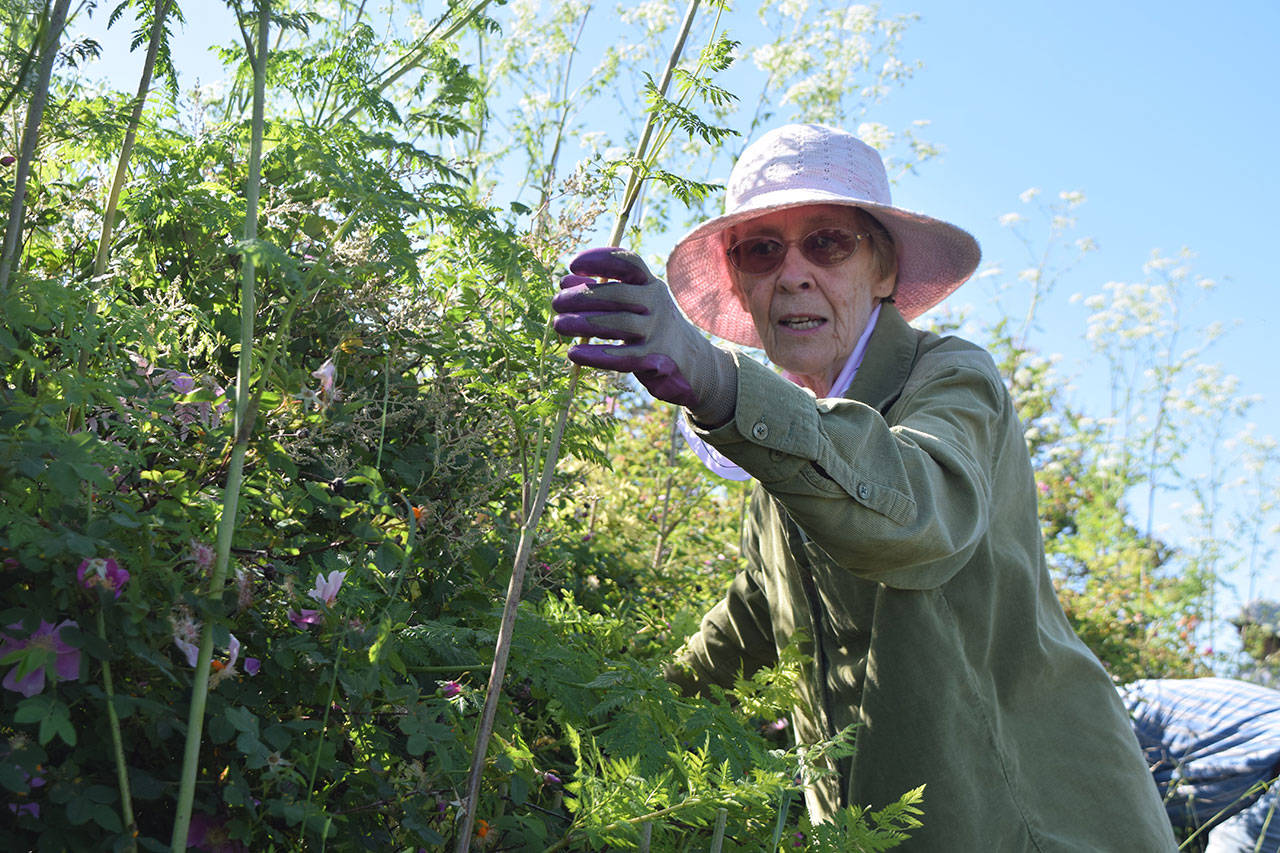For nearly a decade, Jean Wilcox has been the bane of poison hemlock at Sunlight Beach.
But, since she hurt her leg last year, the noxious weed has reclaimed the majority of the area she regularly patrolled.
“For the past eight or nine years, it’s been my personal project to clear the area since a lot of people walk on the dike to the beach,” said Wilcox, 81. “But, I realize it’s a bit beyond me now, so I asked for help.”
Her neighbors answered. On Monday a crew of volunteers rallied together to help remove the poisonous weeds. It was a good time to do it as poison hemlock is currently in bloom and seeding. The half a dozen Sunlight Beach residents who gathered to clip, unearth and bag the invasive species growing on top of the dike that stretches from Useless Bay Golf &Country Club to the waterfront made short work of the weeds, filling five garbage bags in about 30 minutes.
Present in the effort was the weed wizard herself, as Wilcox brushed off her injuries to get her hands and knees dirty while eagerly offering suggestions to volunteers on how to best kill the tall, bamboo-like plant with a blotchy purple stem.
The county relies on community members such as Wilcox to get rid of the various noxious weeds that have invaded Whidbey’s ecosystem. Island County currently employs a single worker to handle the entire island’s noxious weeds; eradicating them all is an impossible task for one man.
“We want to enable our community to take an active ownership in terms of control of these noxious weeds,” Island County Noxious Weed Coordinator Seth Luginbill said. “It really is a community effort, and if everyone jumps on board, we’re going to gain a lot more headway on these infestations.”
The county accepts bags of cut noxious weeds free of charge.
Luginbill said that due to the lengthy winter, many of the island’s noxious weeds are in bloom, and that people and their animals should avoid contact with them. Poison hemlock, identified by their white flowers and tall, hollow and partially purple stems can grow up to 8 feet, and carries an “acute toxicity for wildlife and humans” that can cause respiratory paralysis if ingested. If it touches the skin, the plant can cause irritation.
“Socrates was actually poisoned by poison hemlock,” Sunlight Beach resident Coyla Shepard said. “It’s a toxic plant, and it’s everywhere.”
Wilcox said many residents don’t remove the invasive plant, since many find their white flowers pretty. However, she warned that’s the most important time to remove them, as the flowers bring seeds that spread like wildfire. Removing the weeds in their first year is best, as they’re still shorter than two feet and can be easily yanked from the ground, she said. In the second year, poison hemlock shoots up in growth.
“I generally pass through to clear the poison hemlock in the winter when they’re easier to remove,” Wilcox said. “If you see ones that are 8-feet tall, I find it best to cut near the root and spray small amounts of herbicide to kill it and stop the spread of seeds.”
Luginbill said poison hemlock and a number of noxious weeds require repeated efforts to prevent them from spreading. He said the county’s goal is to achieve what it calls “control,” since eradication in many cases can be an impossible task. The county offers consultation on management and identification of noxious weeds, as well as hands-on control work to manage the spread in critical areas.
To contact the county regarding noxious weeds, call 360-678-7992.
However, it’s volunteers like Wilcox that have the power to stop the spread.
“For eight or nine years, Jean has been taking care of the area all by herself,” Shepard said. “And I’m glad she has because they cover the dike, and a lot of people walk along here with their dogs.”



